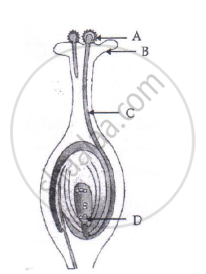Advertisements
Advertisements
प्रश्न
Bisexual : Hibiscus : : Unisexual : ___________
उत्तर
Bisexual : Hibiscus : : Unisexual : Papaya
APPEARS IN
संबंधित प्रश्न
Answer the following question.
What is pollination? Explain the different types of pollination.
How does fertilisation occur in flowers? Name the parts of the flower that develop into (i) seed, and (ii) fruit after fertilisation.
In the following diagram showing the structure of embryo of a dicot seed, what are the parts marked I, II and III sequentially?


(i) Name the part marked 'A' in the diagram.
(ii) How dose 'A' reachese part 'B'?
(iii) State the importance of the part 'C'.
(iv) What happens to the part marked 'D' after fertilisation is over?
A student identified the various parts of an embryo of a gram seed and listed them as given below :
(I) Testa
(II) Plumule
(III) Radicle
(IV) Cotyledon
(V) Tegmen
Out of these the actual parts of the embryo are :
(A) I, II, III
(B) II, III, IV
(C) III, IV, V
(D) II, IV, V
Explain what you understand by sexual reproduction.
What is the name of female part of a flower?
Where is the female gamete formed in flowering plants?
Name the part of a seed which contains stored food.
(a) Draw a neat diagram of a flower showing its various parts. In this diagram mark stem, receptacle, sepals, petals, stamen and carpel.
(b) What name is given to (i) all the petals of a flower, and (ii) all the sepals of a flower?
(c) What are (i) stamen, and (ii) carpel, in a flower?
(d) What is the other name of carpel of a flower?
(e) What is the name of yellow powdery substance present in the anther of a flower?
One of the following occurs in the reproductive system of flowering plants as well as that of humans. This is :
(a) vas deferens
(b) anther
(c) ovary
(d) style
The correct sequence of reproductive stages occurring in flowering plants is ______
The part of a seed which grows and develops into root on germination is :
(a) cotyledon
(b) plumule
(c) follicle
(d) radicle
When an insect sits on the flower of a plant then some particles A present in the top of little stalks in the flower attach to its body hair. When this insect now sits on the flower of another similar plant, then particles A attached to the hair of insect are put on the top of a flask-shaped organ at the centre of flower. The particle A grows a long tube b from the top of flask-shaped organ through which C moves down and reaches the bottom part of flask-shaped organ. Here C fuses with the nucleus of d contained in structure E. the fusion of C and D forms a new cell f which grows and develops into a seed of the plant.
(a) What are particles A? What is the process of transferring A from one flower to another flower of similar plant by the insect known as?
(b) What is the name of tube B?
(c) What is C which moves down through the tube B?
(d) Name D and E.
(e) What is F?
Put a tick mark (✓) against the correct alternative in the following statement
Pollen is produced in the:
Fill in the blank by selecting suitable word:
A flower bearing only male or female parts is known as __________ flower.
Multiple choice question. Tick (✓) the correct choice:
Unisexual flowers are found in
- mulberry
- mustard
- pea
- sunflower
State whether the following statement is true (T) or false (F):
Stamens make egg cells.
State whether the following statement is true (T) or false (F):
Flowers which possess stamens and carpel are called unisexual.
Write one main difference between asexual and sexual mode of reproduction. Which species is likely to have comparatively better chances of survival – the one reproducing asexually or the one reproducing sexually? Give reason to justify your answer.
Explain the process of fertilisation in flowers.
Describe an activity to demonstrate phototropism.
Fill in the blank by selecting suitable word:
Transfer of pollen grains from the anther to the stigma is known as______________.
Fill in the blanks and rewrite the completed statements:
Lymph flows in _______________ direction.
Differentiate between self-pollination and cross-pollination.
Find an odd one out.
Define.
Inflorescence
Draw a neat and labelled diagram.
Double fertilization in angiosperms
In which of the following manner the arrangement of megaspores in a tetrad is observed in angiosperms?
Antipodal cells are present towards the ______ in an anatropous ovule.
Which of the following is the outermost protective layer of anther?
Which among the following statements are true for unisexual flowers?
- They possess both stamen and pistil
- They possess either stamen or pistil
- They exhibit cross pollination
- Unisexual flowers possessing only stamens cannot produce fruits
Is the chromosome number of zygote, embryonal cells and adult of a particular organism always constant? How is the constancy maintained in these three stages?
Double fertilization is exhibited by ______
Consider the following three flowers namely X, Y and Z. Which flower(s) would develop into a fruit?
| Flower X | Flower Y | Flower Z |
 |
 |
 |
- Assertion: Primary endosperm nucleus is diploid.
- Reason: It is the product of double fertilisation.
